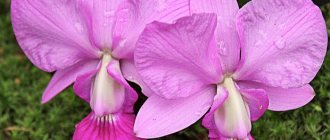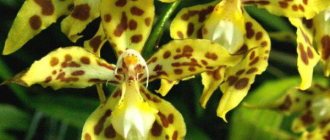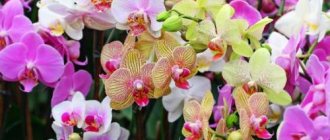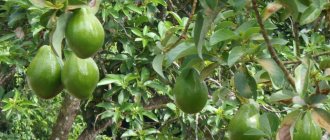The orchid has long become a familiar resident of our apartments and houses. They give it as a gift for holidays, collect it, and don’t think about what it looks like in the wild.
It is important for owners of each domesticated species of orchids to know what the conditions of their natural growth are.
Knowing in which country representatives of a particular species grow, the florist will better understand what an exotic beauty needs.
How an orchid grows in nature
The orchid is a fairly common plant, with up to 35,000 varieties. The culture is widespread almost all over the world: it is found on every continent in temperate and tropical latitudes. However, most of it is concentrated in the tropics, since the most favorable conditions for development are provided.
Orchids require high temperatures and high humidity. They reproduce and grow naturally. The roots hang from surfaces in large bunches. A peduncle always grows near the leaf rosette; plant seeds or flowers are placed on it.
Parts of the world where orchids grow
Let's look at the most common habitats of orchids.
South Africa and Central America
These regions experience heat and high humidity. The root system does not dry out because it is saturated with water from the air. Such climatic conditions are ideal for the growth of Dendrobium orchids, the representatives of which are striking in their variety of colors.
Mountains of Brazil and Andes, southeast Asia
Compared to the tropics, lower temperatures prevail here. But the orchids managed to take root in such conditions thanks to good lighting and high humidity. Almost all representatives of orchids live in these regions.
The Cattleya variety, growing up to 150 cm, has adapted well to low-temperature conditions.
Plateaus and steppes
Here the climate is not as favorable as in the tropics, so local crops had to adapt to growing in the ground. Orchids also changed their appearance due to sudden changes in daily temperatures.
The most commonly found orchid in these regions is the Orchis orchid, which is decorated with many purple flowers.
Temperate zones
Finding an orchid here is very rare. There are only those species that can grow in the ground. However, in Thailand, orchids grow almost everywhere.
Photo
In the photo you can see where these flowers grow in nature, how they look on trees and in other habitats.
Classification of wild orchids
Saprophytes
Noticeably different from the orchids we are used to. This variety grows underground. It has no leaves at all, only white thickened roots. Externally, saprophytic orchids resemble corals.
The thin trunk of this species is covered with scales. The flowers do not attract attention, they are small, but they exude a pleasant, pronounced aroma.
Saprophytes easily survive for long periods of time without sunlight and are capable of parasitizing other crops.
Epiphytes
Their main difference is the presence of a powerfully developed root system, which is involved in the process of photosynthesis. The most common species for home cultivation - Phalaenopsis and Vanda - are epiphytes. Thanks to aerial roots, epiphytic crops can freely adhere to vertical surfaces - on stones and trees. At the same time, the plant does not cause any harm to the tree.
The variety of colors of the petals makes epiphytes most attractive to insects, which facilitates propagation by seeds. The seed remains viable for 24 months, since even in optimal conditions it is difficult to find the ideal place for the sprout. Epiphytes can bloom all year round.
Methods for propagating dendrobium orchids at home
Terrestrial species
Characterized by a traditional root system. Suitable for growing in temperate climate zones. Roots and green shoots go deep into the soil, which should be well enriched with oxygen.
When the root system grows, the ground orchid resembles a huge bush. Water accumulates in powerful shoots and pseudobulbs. Under unfavorable conditions, the crop sheds some of its leaves.
Growth form
Monopodial - varieties of orchids that have one long stem growing vertically, and from the base of the shoots (pseudobulb) or axils of fleshy, dense leaves, which contain all the nutrients and microelements necessary for the full growth and flowering of the plant, several flower stalks can emerge. These are phalaenopsis, vanda, agrekcum, aerangis.
Sympodial - this group includes species of orchids that grow horizontally. They look like creeping vines, from which shoots emerge that connect to the root system. It is in these shoots that moisture and nutritional components accumulate. The leaves of this group of orchids are much narrower and thinner than those of the first species, and die off much faster than those of monopodial ones. These are Cymbidium, Cattleya, Oncidium, Cambria.
Variety of colors
Due to the diversity of species, it is difficult to say with accuracy how many colors the Orchid family has in nature.
We can definitely say that there are buds of all primary colors and their shades.
"Like an egg"
The origin of the orchid is shrouded in legends. According to one ancient myth, this flower appeared from particles of a split rainbow. Another legend claims that orchids began to grow where the beautiful Aphrodite lost her sandal. Whether these legends are true is unclear. But the orchid family has aroused interest among people in different times and eras.
Beautiful, picture-perfect exotics got their name back in Ancient Greece. Plato's student Theophrastus, as a result of his scientific research, discovered a flower unfamiliar to him. The plant had a thickened root that looked like a pair of onions. The philosopher's imagination allowed him to compare this part of the flower with male testicles. Since then, the name “orchis” (from the Greek “testicle”) has been firmly attached to the flower.
Living in the 1st century AD. The scientist Dioscrides gave a description of the orchid in his writings. According to him, this flower was known to the Mexican Aztecs. They used exotic plants to create drinks.
Many centuries later, an English gardener named Cattley introduced the orchid to Europeans. He planted the mysterious plant in a pot and watched as fragrant flowers formed on its shoots. In memory of the inquisitive gardener, the orchid genus Cattleya was named.
In the 18th century, Britain was gripped by a real “orchid fever.” Growing these flowers was considered a noble activity. Avid collectors were not put off by the price of exotics - 500 pounds for one flower!
Life cycle
Wild orchids have many varieties, each of which differs not only in appearance, but also in the subtleties of reproduction and development. The one thing that all species have in common is longevity. Under natural conditions, orchids can live up to 80 years (and some species live for more than a century).
REFERENCE! In ancient Japan, orchids were inherited, which once again proves the life span of plants.
Differences from home
It is worth noting that most home orchids are hybrid specimens. No matter how hard botanists tried to create optimal indoor conditions for the wild orchid, no one was able to complete the job. Therefore, we had to resort to the help of breeders.
The next difference is life expectancy. Domestic specimens live a maximum of 10 years. Also, domestic crops, when optimal conditions are created, can bloom all year round, but among wild varieties only a few species are capable of this.
Home orchids also do not need support; they grow vertically. These species usually have larger flowers, but are inferior in number to wild varieties.
Horticultural crops
And yet the beauty of orchids has not gone unnoticed by gardeners. Among the forest orchids, there are still some that can be grown in home plots. These include the forest orchid - leopard lily. A beautiful exotic plant can be grown from seeds, which some nurseries sell online. The plant's homeland is China, but it takes root well in our gardens. Belamkanda chinensis, also known as forest orchid and leopard lily, has a very long flowering period. The plant is a perennial and reproduces well in gardens by self-sowing.
It came to be called the leopard lily due to the presence of dark orange spots on the beautiful flowers. The plant is also called blackberry lily because its seeds resemble these berries. In general, the culture is unique and there is nothing else similar to it in the world. The plant is incredibly common throughout China. In addition, it can be seen in Indonesia, Japan, Northern India and Eastern Siberia. In nature, the plant grows in sparse forests, on rocky cliffs, on the slopes of rice fields and even along roadsides.
Belamkanda was brought to us from East Asia. Now it is grown in gardens as an ornamental plant with graceful, beautiful flowers. The perennial plant has yellow-orange or reddish flowers with characteristic dark dots. Moreover, they are collected in large inflorescences in the form of wide brushes. The blossomed flower reaches five to seven centimeters in diameter.
In our latitudes, the orchid begins to bloom at the end of July. It pleases with its beauty until the end of August, and sometimes until the beginning of September. An interesting fact is that each flower has a very short life. It only blooms for a couple of hours. It opens in the first half of the day, and begins to fade closer to sunset. Externally, fading simply looks like curling. And the next day, in the morning, new flowers are already opening on the stem. Here is such a unique plant - leopard orchid.
In autumn, the plant ripens seeds in capsules that look like blackberries. Belamkanda reproduces well by dividing rhizomes, as well as by seeds, which are grown even indoors for later replanting in open ground.
Features of growth
Let's look at some of the subtleties of growing orchids in the wild.
Reproduction naturally
Most often, wild orchids reproduce by seed. Seed material is carried by the wind over kilometer distances, so the same varieties can be found in opposite parts of the region. In rare cases, reproduction occurs through the light of the lateral processes.
Why does a flower grow on trees?
Under natural conditions, an orchid needs support for normal development. This is why plants are often found on trees. But only epiphytic specimens grow this way. Plants with a well-developed root system are attached by their roots to the surface of the tree (it is desirable that the bark be rougher, so the adhesion will be more reliable).
Humus and moisture collect in the cracks of the bark, as well as numerous microorganisms on which the epiphytic species of wild orchid feeds. In addition, the tree bark protects from the scorching sun.
REFERENCE! Such species can also be found on rocks and rocks.
What is the difference between indoor plants and wild ones?
You need to understand that indoor plants are always the result of the painstaking work of breeders. Creating conditions as close to natural as possible for growing wild orchids is almost impossible and takes a lot of time.
Many domestic specimens easily live in the ground and are less demanding of environmental conditions.
First mentions
Forest violet in the wild
Today you can easily grow an orchid at home, but where did it come from in big cities? The very country of origin of the flower is unknown for certain, but the first mentions are found in Chinese manuscripts dating back to 500 BC. e. According to historical references, the famous philosopher Confucius wrote that the smell of the flower is reminiscent of the words of love of loving hearts.
Also in China, scientists found a manuscript dated 700 BC. e., which describes in detail how the artist W. Mei cultivated a flower in a small pot. Since then, people all over the world have learned about this amazing flower, its beauty, smell and medicinal properties.
But, probably, the most beautiful name for the flower was given by the ancient Greek Theophrastus, a philosopher and thinker, who found a plant with pseudobulbs and named it “Orchis”. Translated from the language of the ancient Greeks, this is translated as “testicle”. And all this happened in the 300th century. BC e.
The first mention of an orchid was recorded in China
Orchids in nature - photo gallery
A wild orchid differs from a domestic one both in appearance and in its growth characteristics.
There are many species of the Orchid family found in nature, so even botanists still cannot name the exact number.
Legends about a beautiful flower
A very interesting legend is associated with this plant of the orchid family. Once upon a time, in one fairy-tale country, butterflies landed on a plant and could no longer fly away, because they turned into beautiful flowers.
But the legend of ancient Greek mythology tells how Venus’s shoes turned into a beautiful flower. Adonis and Venus were caught in a thunderstorm and hid from the weather in a secluded place. And the goddess’s shoe remained lying on the ground. At this time, a man passed by and saw a golden shoe. As soon as he decided to pick it up and extended his hand, it turned into a flower that looked like a shoe.











